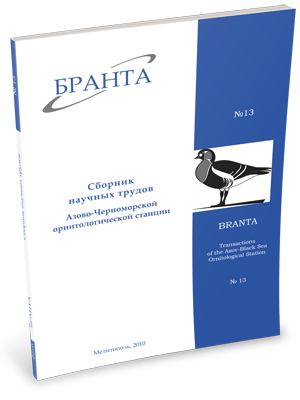
Transactions
of the Azov-Black Sea Ornithological Station



New data on records of Kittiwakes in the north-east areas of the Azov-Black Sea basin.
M. A. Dinkevich
By the beginning of the 21st century in the Azov-Black Sea Basin, within borders of the former USSR, had been known extremely rare coastal visual records of Kittiwakes proved with ringing data. Most of ornithologists permanently working at the coast of the two southern seas have never registered this species. This work is based on data of marine expeditions of the Southern Scientific Centre (10-30.04.2008; 16-26.06.2008) covering the water area of the Azov and Black Seas from the Don mouth and Taganrogsky Bay to the Russian-Abkhazian border (village Veseloye, Psou River), and our periodical field trips along the coasts of the southern seas within Krasnodar Territory since 1995. Over the period 2003- 2009 along all the Azov-Black Sea coast and central reservoirs of Krasnodar Territory and Adygei Republic there were carried out waterbird counts. The marine surveys of birds was made using transect method (Gould, Forsell, 1989) from the board of the motor vessel “PTR-50 Deneb” 300 km from each side of the ship. In the Black Sea close transects went 1.5-7 km, distant transects 10-18 km from the shoreline until borders of the economical zone of Russian Federation. The shipboard bird surveys were during daylight, coordinates recorded every 15 minutes or, along the most distant Black Sea transects, – every 30 minutes by GPS navigator. Coordinates of Kittiwake observations were recorded separately with each registration of the species. For observations there were used binoculars with 12-times magnification and telescopes (up to 60x). During coastal observations kittiwakes (exclusively under-yearlings) were registered 03.02.2007 in Kerch Strait at Port Kavkaz (3 ind.), 17.11.2007 at Tamansky Bay in the village of Taman (1 ind.), 14.12.2007 in Kerch Strait between the village of Ilyich and Akhilleon Cape (2 ind).
During marine shipboard observations we saw Kittiwakes more frequently (April 2008, the Black Sea, from Zhelezny Rog Cape to Tuapse City). For 6 days of counts we have registered 48 ind. (22 registrations), 14 of them met along transects (8 records), and 34 – out of transects (14 registrations). The yearlings made up 97.9% of birds. Of 22 registrations 16 were single birds, 2 times we saw 4 gulls at once, and additionally 2, 3, 6 and 13 ind. at each time. The Kittiwake number along all the Black Sea transects was equal to 0.29 ind./10 km, density – 0.05 ind./km2, percentage in population – 1.55%.
Along the close Black Sea transect (length is 249.8 km, area 149.9 km2), with the highest frequency of the species records, the relevant parameters amounted to 0.56 ind/10 km, 0.09 ind/km2, 2.19%. At the distance of 1.5-7 km off the shore it was registred 43 Kittiwakes (17 registrations); further (10-18 km) only 5 gulls observed (5 records). The most important for Kittiwakes were such regions as Anapa City – Utrish Cape (9 records, 19 ind) and Gelendzhik City – Dzhankhot Village (4; 16), which held 59.1% records and 72.9% observed birds.
Stay of Kittiwakes (mostly immature) in the Azov-Black Sea region is regular and cannot be considered as accidental visits. First birds arrive since late August, and leave the area in April-May; summer records are extremely rare. During passage the Kittiwakes fly not only along the coast but also over inland water bodies. Movements of Kittiwakes are related to movements of the European anchovy and other small fishes. There is a need of further shipboard observations to specify numbers and distribution of Kittiwakes in southern seas.
Read the paper in a PDF file